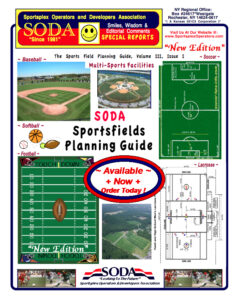Aug 24, 2015 · Paul Zwaska
Rakes of all shapes, sizes and configurations are vital crafting tools for the ballfield groundskeeper. Like the tools in a cabinetmaker’s toolbox, each tool has its preferred use and specialty on a ball diamond. Some can be fairly specialized while others can be used for a wide variety of operations. Just like a supermarket’s cereal or chip aisle, there are more choices then one knows what to do with sometimes. Most of the chores you will perform with your rakes/grooming tools include the following:
- General raking – Just moving soil around, raking out the trash, rocks, and spoils
- Rough grade work – When the grade doesn’t need to be precise and totally smooth
- Fine grading – Sod prep, infield skin leveling or game ready finish
- Back raking – Using the rake in a reverse direction (pushing) in order to fluff up or cut shallow fine textured valleys and ridges in the infield soil or topdressing to speed drying of the surface of an infield skin after a rain event
- Scarification – Cutting down high spots on clay or infield skin areas, loosening the surface of the soil areas
- Lip Removal – Loosening and removing soil and topdressing that is glued into the turf edges of the skinned area or warning track by rain and irrigation
Which tools work best for each operation? Below is a chart that looks at the various tasks and ranks how each of the tool’s performances typically pan out. Keep in mind that ultimately the choice of tools for a task usually falls on the personal preference of the groundskeeper performing the task. Everyone has their favorites but the chart should give you a place to start if you are looking for the right tool for the job.
Long Tooth Aluminum Grading Rake:
Your basic standard issue ground crew rake. Nothing special here, but it can do most basic jobs fairly well and usually comes in several different widths, from 24” to as wide as 60”, depending on the tooth style chosen. These rakes tend to be the workhorse of a ground crew. They can take the real “bull” work of rough grading and general raking better than any other rakes.
Short Tooth Aluminum Grading Rake:
The short tooth rake leaves a fine grade, good for finish work after trash (pebbles, dead grass clippings, clay chunks, etc.) has been removed on skin areas. The sharper teeth are suitable for shallow scarifying. Will struggle if used for general raking or rough grading. You really need the longer teeth for that operation.
Double Play Aluminum Grading Rake:
The best of both worlds! Short and long teeth on one rake makes this rake more versatile. It can be used in many different applications. This rake is not for everyone though. Some people prefer to have the straight edge on one side of the rake instead of teeth on both sides.
Wooden Grading Rake:
A great all-around rake, a wooden grading rake is not as bulky and awkward as an aluminum grading rake. This lightweight rake truly excels with finesse work where detailed finish grading is desired. I’ve found that groundskeepers either really love this rake or they hate it. It all comes down to personal preference. The teeth are easily replaced if broken. Unfortunately the main manufacturer in the U.S. recently moved their plant and the over 100 year old machine that creates these rakes is proving very testy as they attempt to get it up and running. We hope it returns soon.
Aluminum Screening Rake:
If you are dealing with pebbles and rocks on your infield skin, this rake can be your best friend. The screening rake, combined with a steel mat drag and a sifter scoop shovel will help to greatly reduce the population of pebbles and stones in the infield skin over time. This rake will also do an adequate job in rough grading and removing other trash from the soil as it is graded.
Iron Rake:
There are several things to look for in order to have the right iron rake that can be productive for you.
1) Use a “level head” rake (T-shaped head as pictured to the left). Avoid a “bow rake” as these tend to vibrate or jump when pulled on hardened soil.
2) Make sure it has curved teeth. The curve places the teeth at a better angle for cutting into soil.
3) Sharpen the tines on the back. Grind the bottom ¼ of the tine of the rake on the back side down to a sharp point as illustrated to the left. A sharpened rake reduces the amount of effort the operator must apply in order for the rake to cut into the soil. This is especially true when shaving down high spots in mound and home plate clay areas and shaving out the small hardened lips along the turf edges of the infield skin.
Fan/Leaf Rake:
Used mainly for removing loose infield soil and topdressing out of turf edges before rain or irrigation glues it in tightly.
Lute Rake:
There are lots of different lute scarifying rakes available on the market, but the key to this lute rake is the curve in the rake head. That simple improvement over the other flat lute heads improves its ability to pull larger amounts of soil on the flat edge side without excessive operator fatigue. The curve also improves the performance of this tool for back raking wet infield skins on the serrated edge, especially those using infield topdressing.
Level Board:
The level board is the best fine hand grading and leveling tool available for groundskeepers. The stainless steel reinforced edge insures a strong cutting edge while the relief angle on the back of the level board head allows the tool to float on the surface more easily than the back of any metal rake. The 54” wide head improves grading and leveling on large areas. You should pperate it in much the same manner as a road grader operates its blade.
This blog provides a general direction as to the grooming tools to use for the tasks listed but every groundskeeper has an opinion or favorite tool. Lets get some feedback from our readers/groundskeepers out there. Tell us your preferred grooming rakes for various tasks or whether you agree with our ranking of the tools.
-
-
Beacon Athletics
-
800-747-5985
-
8233 Forsythia St., Suite 120
Middleton, WI 53562
Customer Service Center M-F 7:00 am – 4:30 pm (CST)
Toll-Free: 800-747-5985
Email: [email protected]
-






0 Comments